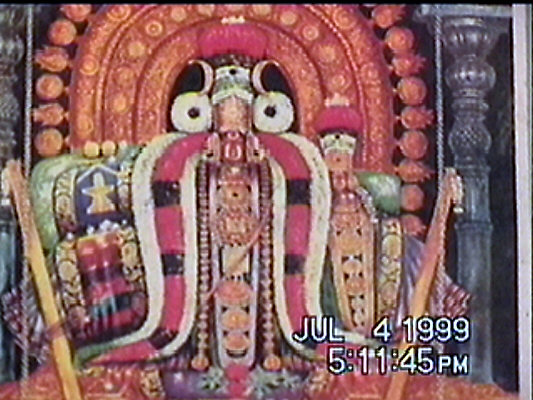Tyagaraja
is the name given to the Somaskanda
manifestation of Shiva at Tiruvarur and 6 of the other Sapta Vitanka shrines.
The Somaskanda
manifestation of Shiva features Shiva, Uma and Skanda; Shiva in a seated posture, with
Parvati to his left and with Skanda his son, seated in between the two.
The Tyagaraja shrine assumes a
special place in each of the above temples. There are shrines to Tyagaraja
at a few other Shivastalams such as Tiruvanmyur
and Tiruvotriyur. Tyagaraja
is referred to in the ancient Tevaram hymns of Tiruvarur as Veedhi
Vitankar. The Tyagaraja shrine at
Tiruvarur is of special significance.

The term Vitanka (Veedhi Vitanka as
in Tiruvarur) represents the Tyagaraja image, as well as the Shivalingam (made of precious
stone, placed in a silver casket) that is also enshrined in the shrine dedicated to Tyagaraja
to the right of the image.
The term Vitanka (sanskrit) refers
to that which is not sculpted. An emerald Shivalingam in the Tyagaraja shrine at Tiruvarur
is offered all the ritual ablutions and services. In the context of the Tevaram hymns, the
term Vitankar refers to a person (Shiva) of extraordinary beauty.
The name Tyagaraja assumed popularity only from the Maratha
period (17th century) in Thanjavur. Tyagaraja at Tiruvarur has been
referred to as Aaruran or Veedhivitankar by the Tevaram
hymns of the 1st millennium CE and by the Chola inscriptions.
The first references to the name Tyagaraja
- or the Great Giver goes back to the tamil work of the court poet Ottakoothar
of the Chola Kingdom in the 12th century. The Mucukunda
Sahasranamam which dates back to this period also refers to the Tyaga (or the
giving) attributes of Vitanka.
Also see:
Tyagaraja at Tiruvarur
Ajapaa Natanam
Saptavitanka Stalams
The Somaskanda Legend
Somaskanda Iconography
Mucukunda Chakravarti Legend
